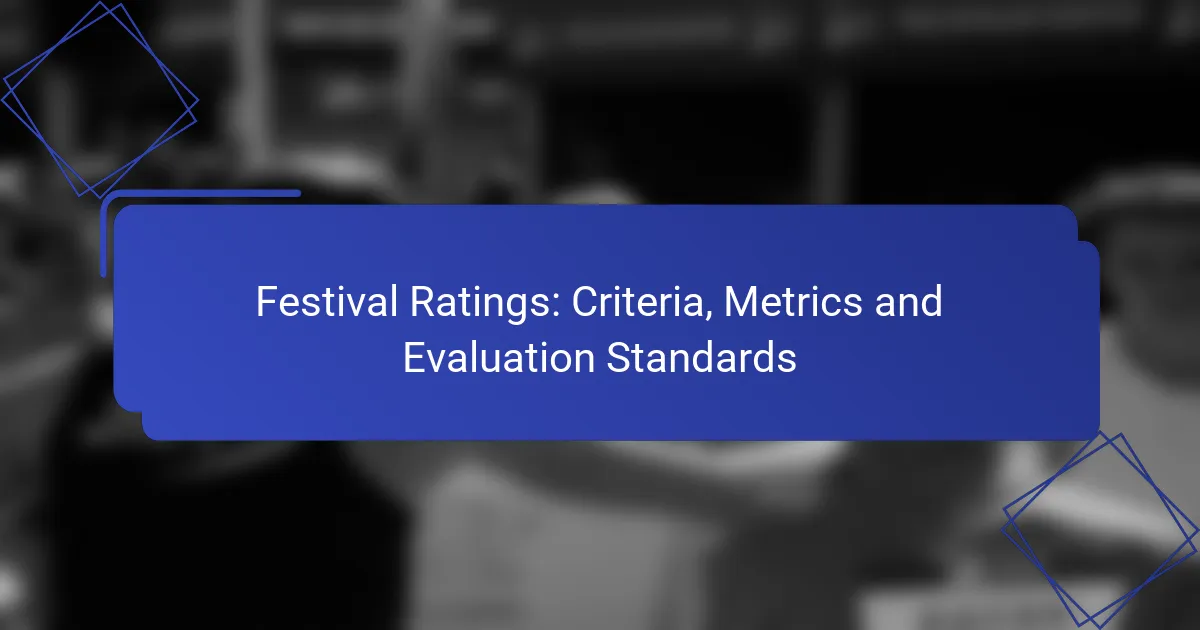Festival ratings play a crucial role in evaluating the overall experience and quality of events, relying on key criteria such as attendance, artist lineup, and venue facilities. By employing structured metrics and standards, stakeholders can gain insights into both the quantitative and qualitative aspects of a festival, ultimately guiding improvements and enhancing future experiences.

What are the key criteria for festival ratings?
Festival ratings are primarily determined by several key criteria that assess the overall experience and quality of the event. These criteria include attendance numbers, artist lineup quality, venue facilities, safety measures, and audience engagement, each contributing to the festival’s reputation and success.
Attendance numbers
Attendance numbers are a crucial metric for evaluating a festival’s popularity and success. A well-attended festival typically indicates strong interest and effective marketing, with successful events often attracting thousands of attendees. For example, festivals with attendance figures in the range of several thousand to tens of thousands are generally viewed as more successful.
When assessing attendance, consider comparing the numbers to previous years or similar festivals to gauge growth or decline. High attendance can also impact logistics, such as crowd management and resource allocation.
Artist lineup quality
The quality of the artist lineup significantly influences a festival’s appeal. A diverse and high-profile lineup can attract larger crowds and enhance the overall experience. Festivals featuring well-known headliners alongside emerging artists often create a balanced offering that appeals to various audience segments.
When evaluating lineup quality, consider factors such as genre diversity, the reputation of the artists, and the presence of exclusive performances. A strong lineup can elevate a festival’s status and lead to higher ratings.
Venue facilities
Venue facilities play a vital role in the overall festival experience. Factors such as accessibility, restroom availability, food and beverage options, and seating arrangements contribute to attendee satisfaction. Festivals held in well-equipped venues tend to receive better ratings due to enhanced comfort and convenience.
When assessing venue facilities, consider the layout and design, as well as the availability of amenities. Festivals that prioritize attendee comfort and convenience often see positive feedback and higher ratings.
Safety measures
Safety measures are essential for ensuring a secure environment at festivals. Effective crowd control, emergency response plans, and health protocols contribute to a safe experience for attendees. Festivals that prioritize safety tend to earn higher ratings as they demonstrate a commitment to attendee well-being.
When evaluating safety measures, consider the presence of trained staff, clear signage, and communication of emergency procedures. Festivals that proactively address safety concerns can enhance their reputation and ratings.
Audience engagement
Audience engagement is a critical factor in festival ratings, reflecting how well the event connects with attendees. Interactive experiences, social media integration, and opportunities for participation can enhance engagement and create lasting memories. Festivals that foster a sense of community often receive higher ratings.
To improve audience engagement, consider incorporating activities such as workshops, meet-and-greets, and interactive installations. Festivals that successfully engage their audience can boost satisfaction and overall ratings.

How are festival ratings evaluated?
Festival ratings are evaluated through a combination of structured criteria, metrics, and standards that assess various aspects of the event. These evaluations help stakeholders, including attendees and organizers, understand the quality and appeal of a festival.
Rating scales
Rating scales provide a numerical or categorical framework for evaluating festivals. Common scales include 1 to 5 stars or a percentage score, where higher values indicate better experiences. For example, a festival rated 4 out of 5 stars typically signifies a strong overall satisfaction among attendees.
When using rating scales, it’s essential to ensure consistency in what each level represents. This clarity helps prevent confusion and allows for more accurate comparisons across different events.
Peer reviews
Peer reviews involve feedback from festival attendees or participants who share their experiences. This qualitative data can highlight strengths and weaknesses that numerical ratings might overlook. For instance, comments about the atmosphere, accessibility, or food quality can provide valuable insights.
Encouraging honest peer reviews can be beneficial, but organizers should be wary of potential biases. Implementing anonymous feedback mechanisms can help gather more candid opinions.
Expert panels
Expert panels consist of industry professionals who assess festivals based on established criteria. These experts often evaluate elements such as programming, production quality, and audience engagement. Their insights can lend credibility to the ratings, as they are based on experience and knowledge of industry standards.
When forming an expert panel, it’s crucial to select individuals with diverse backgrounds to ensure a well-rounded evaluation. This diversity can lead to more comprehensive assessments that reflect various perspectives within the festival landscape.

What metrics are used in festival ratings?
Festival ratings are typically assessed using a combination of metrics that reflect both quantitative and qualitative aspects of the event. Key metrics include ticket sales data, social media sentiment, and post-event surveys, each providing valuable insights into the festival’s success and areas for improvement.
Ticket sales data
Ticket sales data serves as a primary indicator of a festival’s popularity and financial viability. High ticket sales often correlate with positive attendee experiences, while low sales may signal issues with marketing or programming. Tracking sales trends over time can help organizers identify peak sales periods and adjust pricing strategies accordingly.
For example, festivals that offer early bird pricing typically see a surge in ticket sales months in advance. It’s essential to analyze sales data not just in total numbers but also in relation to capacity and historical performance to gauge success accurately.
Social media sentiment
Social media sentiment analysis involves monitoring online conversations and reactions related to the festival. This metric can reveal how attendees perceive the event, highlighting both positive experiences and areas of dissatisfaction. Tools that analyze hashtags, comments, and shares can provide a comprehensive view of public opinion.
For instance, a festival that trends positively on platforms like Twitter or Instagram may attract more attendees in the future. However, it’s crucial to consider the context of the sentiment, as a high volume of posts does not always equate to positive feedback.
Post-event surveys
Post-event surveys are a direct method for gathering feedback from attendees about their experiences. These surveys can cover various aspects, including satisfaction with performances, amenities, and overall organization. Analyzing this feedback helps organizers understand what worked well and what needs improvement.
Surveys should be concise and targeted, often including both quantitative ratings and open-ended questions for qualitative insights. A common practice is to offer incentives for completing surveys, which can increase response rates and yield more comprehensive data for future planning.

What are the best practices for rating festivals?
Best practices for rating festivals involve using clear, consistent criteria that ensure fair evaluations. This includes standardized metrics and regular updates to reflect changing trends and audience expectations.
Standardized evaluation forms
Standardized evaluation forms are essential for maintaining consistency in festival ratings. These forms should include specific criteria such as organization, entertainment quality, accessibility, and attendee satisfaction. By using uniform scoring systems, evaluators can provide more objective assessments.
For example, a scoring scale from 1 to 5 can be applied across various categories, allowing for easy comparison between different festivals. This approach minimizes bias and helps in identifying areas for improvement.
Regular updates to criteria
Regularly updating evaluation criteria ensures that festival ratings remain relevant and reflective of current trends. As audience preferences evolve, so should the metrics used to assess festivals. This might involve incorporating new aspects like sustainability practices or digital engagement.
Festivals should review their evaluation standards annually, gathering feedback from attendees and stakeholders. This practice not only enhances the rating process but also fosters community involvement and transparency.

How do festival ratings impact attendance?
Festival ratings significantly influence attendance by shaping public perception and driving ticket sales. Higher ratings often correlate with increased interest, encouraging more attendees to participate.
Influence on ticket sales
Festival ratings directly affect ticket sales, as potential attendees often rely on reviews and ratings to gauge the quality of an event. A festival with high ratings can see ticket sales increase by a substantial margin, sometimes by tens of percent compared to lower-rated events.
For example, a festival rated 4.5 stars or higher on popular review platforms may sell out quickly, while one with ratings below 3 stars may struggle to attract attendees. Organizers should monitor ratings closely and respond to feedback to enhance their appeal.
Effect on marketing strategies
Marketing strategies for festivals are heavily influenced by ratings, as they can dictate the messaging and channels used to promote the event. High ratings can be leveraged in promotional materials, showcasing the festival’s quality and attracting sponsors.
Conversely, if ratings are low, organizers may need to adjust their marketing approach, focusing on improving the festival experience or offering discounts to boost attendance. Utilizing social proof from positive ratings can enhance credibility and draw in larger crowds.

What are the emerging trends in festival ratings?
Emerging trends in festival ratings focus on integrating technology and sustainability into evaluation processes. These trends aim to provide more accurate assessments of festival experiences while promoting environmentally friendly practices.
Use of AI in evaluations
Artificial intelligence is increasingly utilized in festival ratings to analyze attendee feedback and behavior. AI algorithms can process large volumes of data from social media, surveys, and ticket sales to identify patterns and trends that human evaluators might miss.
For instance, AI can assess sentiment from online reviews, helping organizers understand what aspects of the festival resonate most with attendees. This technology allows for real-time adjustments and improvements, enhancing overall satisfaction.
Incorporation of sustainability metrics
Sustainability metrics are becoming a crucial component of festival evaluations, reflecting a growing awareness of environmental impact. Festivals are now rated not only on entertainment value but also on their carbon footprint, waste management, and resource usage.
Organizers are encouraged to adopt practices such as reducing plastic use, enhancing recycling efforts, and sourcing local food and materials. Incorporating these metrics can improve a festival’s reputation and attract a more environmentally conscious audience.



